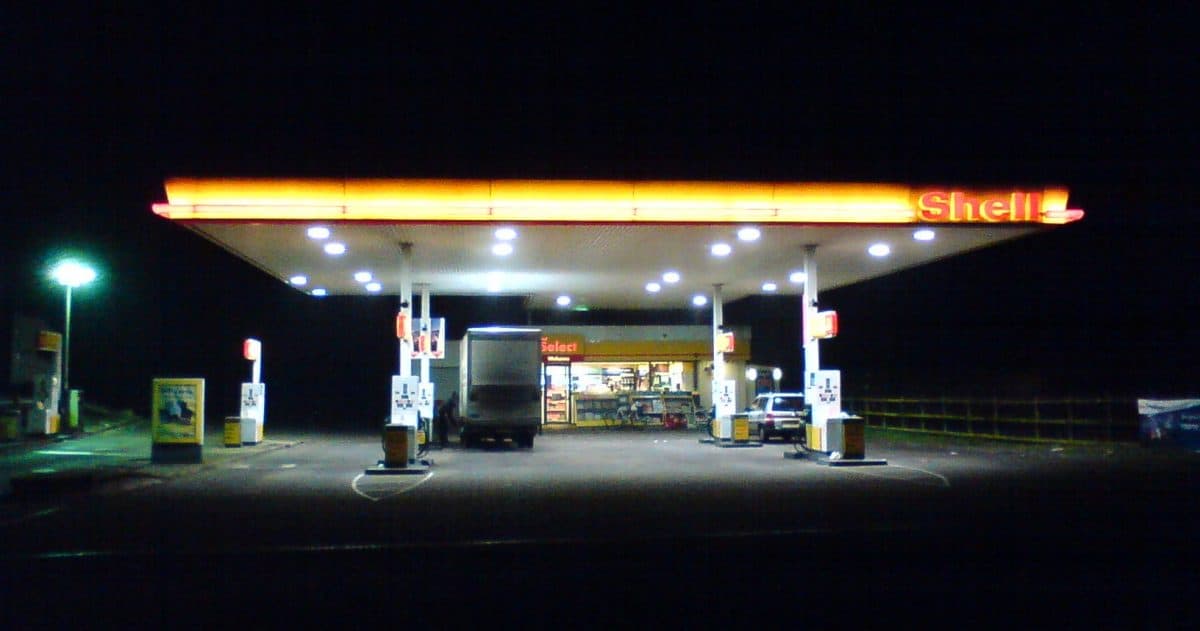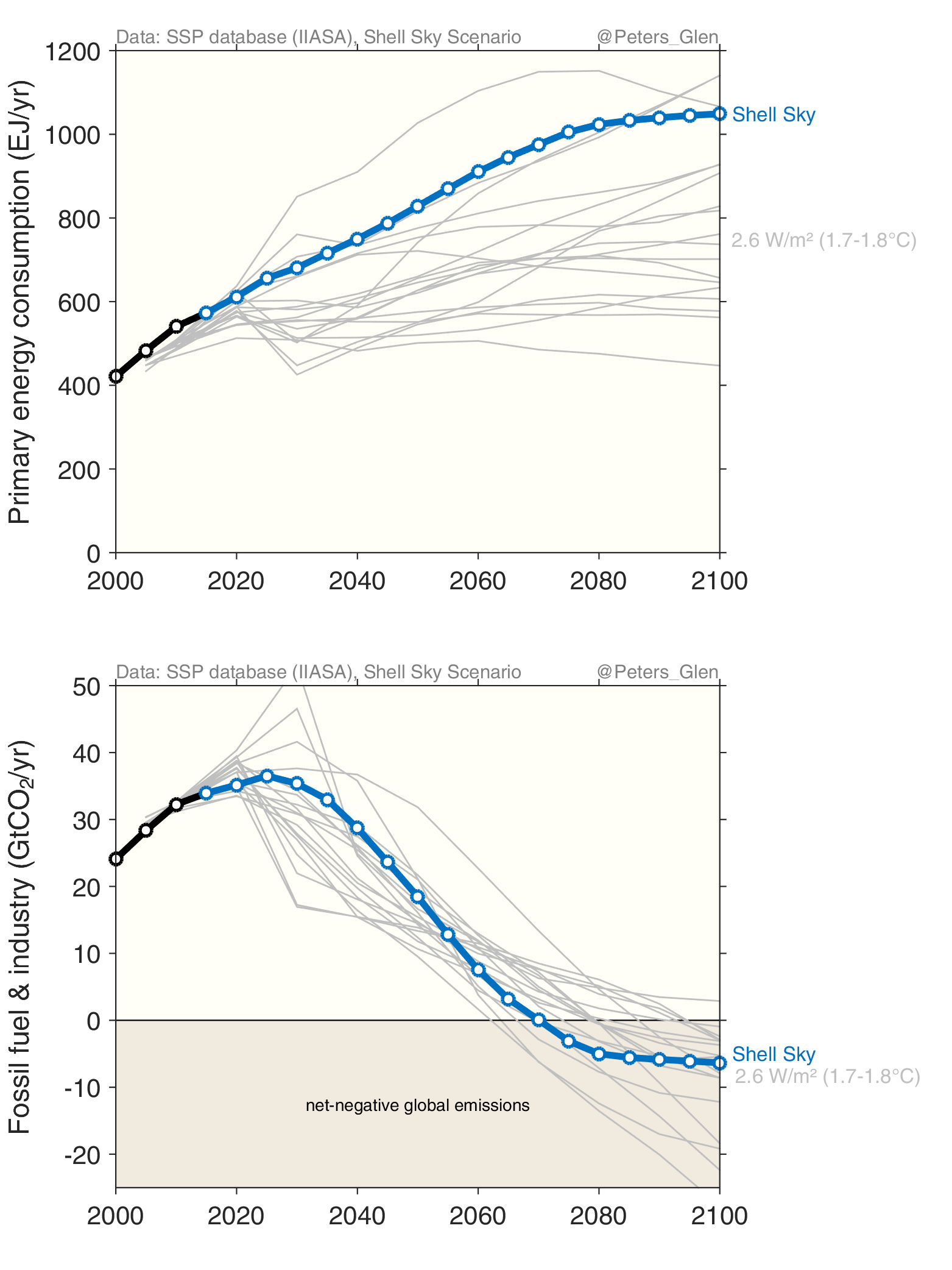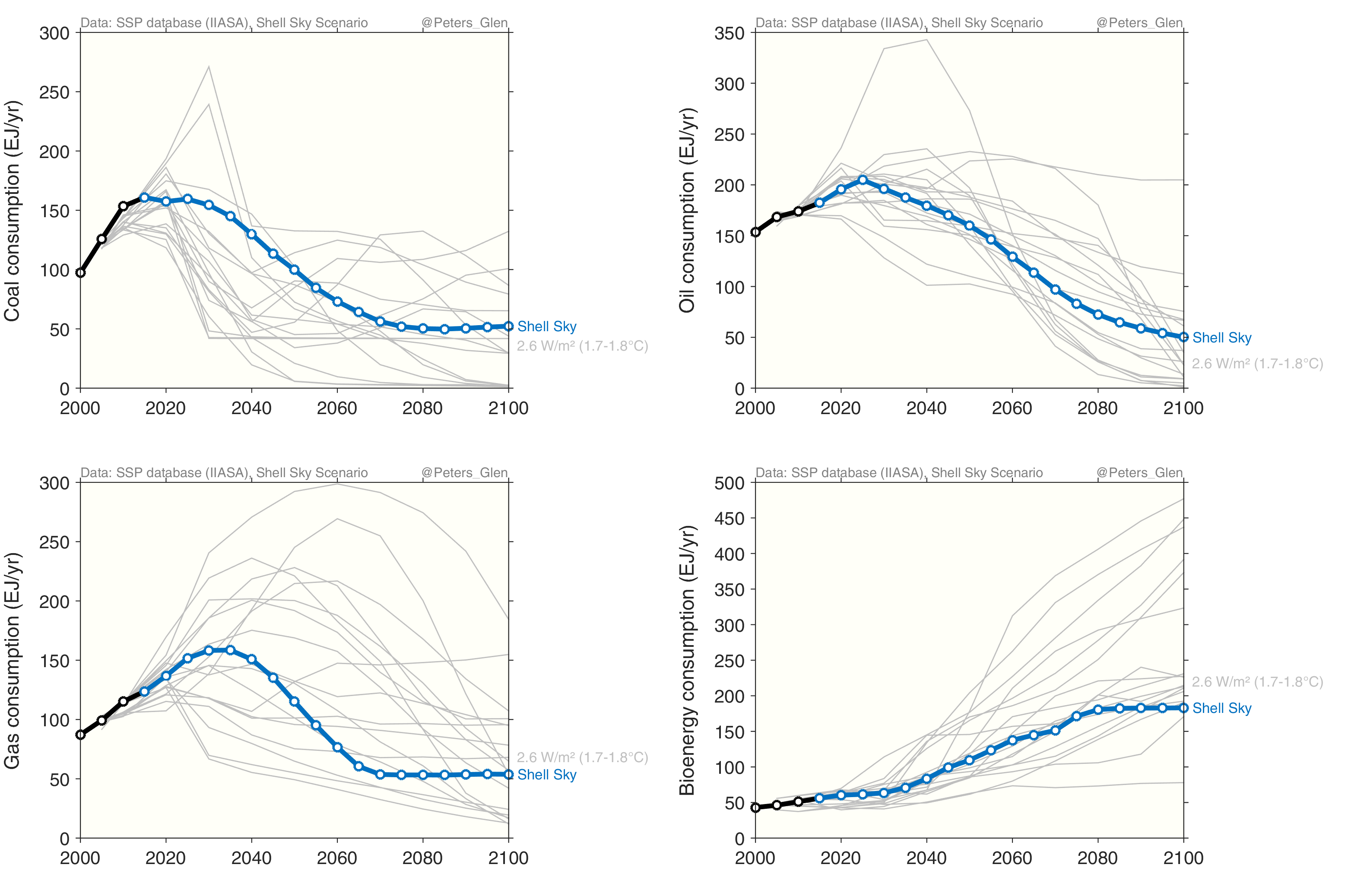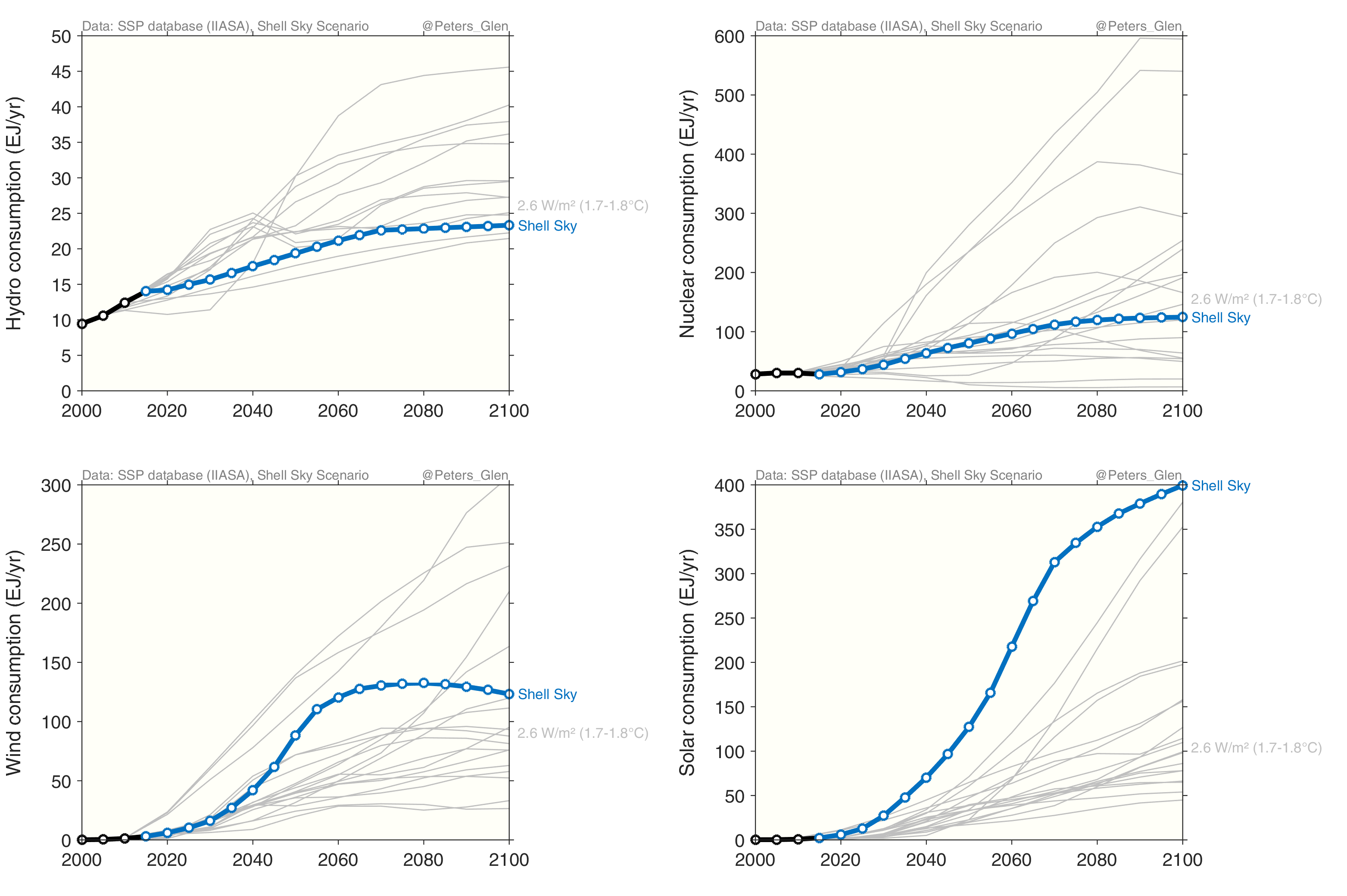Shell in a low carbon world
Shell has just released a new scenario, Sky, which meets the goals of the Paris Agreement. How does it compare with other low carbon pathways?

Shell må kutte sine utslipp kraftig, ifølge den ferske dommen fra Haag. Dommen kan få stor rekkevidde også for andre selskaper som produserer fossil energi, skriver Jenny Sandvig.
We have loads of scenarios consistent with the goals of the Paris Agreement, depending on how «well below 2°C» is interpreted.
The IPCC assessed more than 100 relevant scenarios in the Fifth Assessment Report in 2014, the new Shared Socioeconomic Pathways (SSPs) have about 30 relevant scenarios, a new paper just published 1.5°C scenarios, the International Energy Agency (IEA) has the World Energy Outlook (WEO) and Energy Technology Perspectives (ETP), and other oil companies also do relevant scenarios, such as Statoil.
Shell should be applauded for their new scenario, as it indicates there is an internal discussion of the risks and opportunities that lie ahead.
There is often a presumption that fossil fuel companies produce scenarios that fit their business model, and some argue the IEA backs them up. This is easy to test by comparing with scenarios originating from the climate community. I have now done comparisons for IEA, Statoil, and DNV GL.
Let’s have a look at Shell Sky…
In this post, I only look at data and I don’t pay much attention to the glossy document that comes with it.
Comparing Shell Sky with other 2°C scenarios
In preparation for the IPCC Sixth Assessment Report, the Integrated Assessment Modelling Consortium (IAMC) has developed a new scenario framework, called the Shared Socioeconomic Pathways (SSPs), that will be the foundation of future scenario work.
I will not go into the details of the SSP framework, it is rather complex, but my post on the IEA gives some more discussion and watch Carbon Brief.
It is worth noting that only a subset of the SSP scenario data is available, limiting the ability of researchers to work with the scenarios. Soon, we hope, the public will also have access to the recently published 1.5°C scenarios. But, there is sufficient data publicly available to do an initial analysis of Shell Sky.
A comparison of different scenarios is not easy. Each scenario can have a different socioeconomic background, and different models may give preference to different technologies. The same temperature outcome could be achieved with very different energy systems (e.g., low coal and high gas, or high coal and low gas).
The SSPs have a large range, since they are based on six different Integrated Assessment Models (IAMs), and the five different socioeconomic backgrounds. Shell Sky is one scenario from one model with one set of socioeconomic data. Comparisons should not be made against individual scenarios, but rather, the «cloud» of scenarios in a given space.
My main goal is to assess whether the Shell Sky falls in and around the cloud of other 2°C scenarios.
Shell Sky
In the following figures I show the 2°C scenarios from the SSPs in light grey, with the side-label representing the median value in 2100. The Shell Sky is shown in blue, though not sky blue!
Primary Energy Consumption: Shell Sky sits at the high-end of other 2°C scenarios, with strong and sustained growth in energy consumption. The IEA and Statoil both have much lower primary energy consumption in a 2°C world. One can debate the meaning and usefulness of primary energy consumption, and there is nothing wrong with high energy consumption as long as it’s net effects are benign.
Carbon dioxide emissions. In the next decades, the Shell Sky CO2 emissions from fossil fuels and industry are a little higher than other 2°C scenarios, but by mid-century and towards 2100 Shell Sky is in the middle of the scenario cloud. To be clear, the CO2 emissions from Shell Sky are totally consistent with what is required for 2°C.

Fossil fuels. There are a few characteristics with the Shell Sky scenario that are different to many other 2°C scenarios, though still remaining within the range of other scenarios.
Coal. Shell Sky has relatively high coal consumption throughout the 21st century. Most other scenarios, including IEA and Statoil, have steep declines in coal. To maintain this level of coal consumption will require some carbon capture and storage.
Oil. Oil consumption is in line with most 2°C scenarios, though a little higher than many by 2100. As IEA and Statoil both argue, even with falling oil demand, there is a need for new oil exploration.
Gas. Gas is a really difficult one, with scenarios showing a huge range. No one, really, has a clue what role gas will play in the future. Gas investors beware! Shell has pretty steep declines in gas after a peak around 2030, but it remains in line with most scenarios.
Bioenergy. Bioenergy covers biofuels, solid and gasified biomass, and traditional biomass, and is grouped here with fossil fuels purely for convenience. The Shell Sky bioenergy pathway is rather similar to many other 2°C scenarios, though much higher than IEA and Statoil. The bioenergy is useful later in the century to combine with carbon capture and storage to get negative emissions.

Most 2°C scenarios are quite dependent on carbon capture and storage, something we need to learn to accept. While the SSP database does not provide output for the CO2 in CCS, it is possible to estimate from data on energy consumption.
Shell is at the low end of most other 2°C scenarios, which will surprise people since they mention the need for about 10,000 CCS operations by 2070. Yes, impressive, but nowhere near as impressive as other 2°C scenarios.
A surprise to many, is that the IEA, Statoil, and Shell are all rather conservative on CCS. It is the SSPs that are the bulls! Shell, IEA, and Statoil (the most conservative on CCS) are all similar in 2040, still lower than most existing scenarios.

Renewables. The IEA is always getting mud thrown its way for lowballing renewables. Shell Sky has high primary energy consumption, and if its fossil fuel use is at reasonable levels, then renewables must make up the slack. How does Shell Sky fare on renewables?
Hydro-electricity. Shell Sky is lower than most 2°C scenarios on hydro, with low but steady growth over the 21st century.
Geothermal. Although I have not shown a figure here, Shell Sky has geothermal production at about the same scale as hydro-electricity, and higher than most other 2°C scenarios.
Nuclear. Nuclear consumption is a little lower than the average 2°C scenario. Note that I have scaled up the SSPs by 0.38 to make them consistent with Shell energy accounting.
Wind. Shell Sky has rather rapid growth in wind generation to mid-century, before levelling out and remaining flat. Still, wind is higher than most 2°C scenarios.
Solar. Solar is a standout in Shell Sky. It is the highest of all 2°C scenarios considered here, and higher than IEA and Statoil. Shell sees a solar world!

Aiming for the sky
On balance, the Shell Sky scenario seems rather consistent with other 2°C scenarios. It is certainly not high on fossil fuels and has higher solar and wind than many other scenarios.
Shell Sky does have a few characteristics that stand out from other scenarios. It has high energy consumption, slower declines in coal consumption, and rather high wind and solar consumption.
Now to business? Will Shell push hard on the policy side to ensure the world follows a Shell Sky like world, or will Shell just sit with the herd and see where the world takes them?